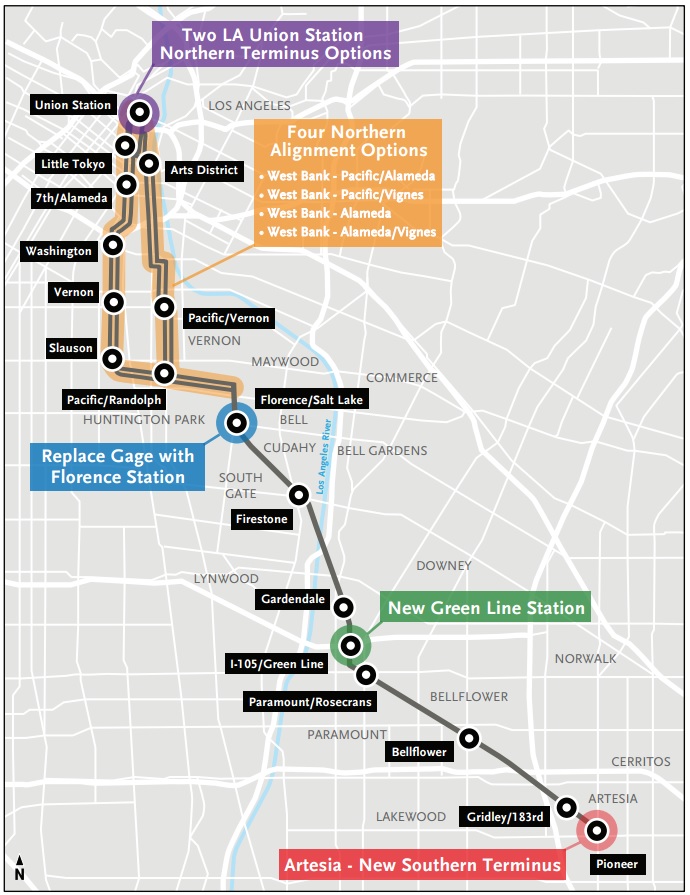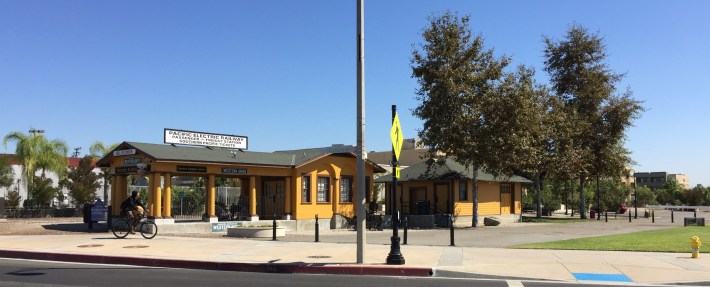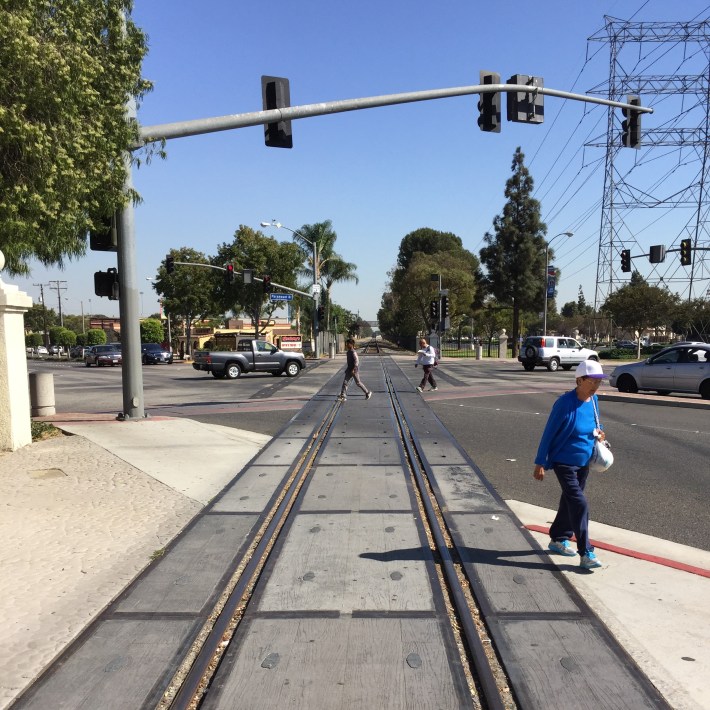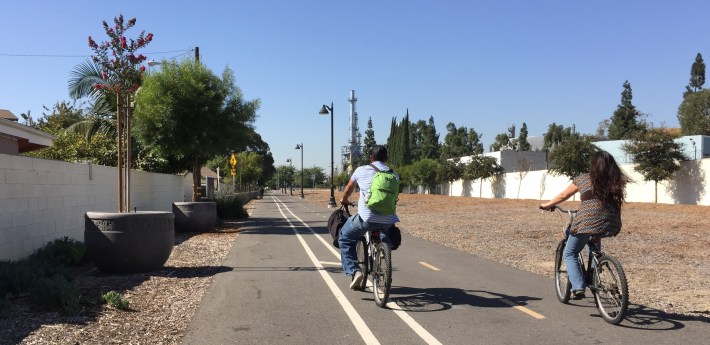Mike Kodama Explains West Santa Ana Branch “Eco-Rapid Transit” Rail Line
2:46 PM PDT on October 11, 2016

Metro's Measure M expenditure plan [PDF] includes two phases of construction of the West Santa Ana Transit Corridor light rail line. These are anticipated to be open in 2028 and 2041. The new rail line would go from Union Station southeast through several cities including Huntington Park, South Gate, Lynwood, Paramount, and Bellflower, with a terminus in Artesia.
The exact alignment, especially for the northern portion of the line, is still evolving, with multiple potential routes. The southern portion of the line would run on an old Pacific Electric streetcar right-of-way. A portion of the route would run along an existing walk and bike trail in the city of Bellflower.
Preliminary work is already underway with this new line. The West Santa Ana Transit Corridor was partially funded in Measure R. Metro did early alignment analysis a while ago, leading to the project's inclusion in CEO Phil Washington's Operation Shovel Ready initiative to get numerous projects ready for potential accelerated timelines. Last month the Metro board approved a four-year $12 million contract with Parsons Brinckerhoff to complete environmental clearance work for the line.
Streetsblog readers may not be aware that, similar to the Gold and Expo Lines, the Eco-Rapid Line has its own Joint Powers Authority. The JPA board includes representatives from southeast L.A. County cities, but also includes the city of Glendale and Burbank Airport, in support of a future vision that would also extend the line northward from Union Station.
Earlier this month, SBLA interviewed Mike Kodama, the Executive Director of the Orangeline Development Authority. The interview took place over email earlier this month.
SBLA: Tell Streetsblog readers about yourself. What's your background? How did you come to be Executive Director of the Eco-Rapid Transit authority?
Mike Kodama: I am a transportation planner. I work on a variety of transportation planning, funding, and policy issues. I have spent a lot of time in many parts of the country developing parking management programs. I have a masters in urban planning from UCLA and I am also a professor teaching transportation planning at USC. I became Executive Director in 2009.
This line gets called "The Orange Line", "Eco-Rapid", and "West Santa Ana Branch." What are all those names?
The formal name is the Orangeline Development Authority. This was because the original concept was to connect Los Angeles and Orange Counties.
A few years ago, the organization was looking for another name so it would not be confused with the Orange Line Bus Rapid Transit project in the San Fernando Valley. They picked the name Eco-Rapid Transit – the idea of economy, ecology, and moving fast.
West Santa Ana Branch is the name of the former Pacific Electric line that ran until the mid-1950s. There is a right-of-way from Bellflower all the way down to Santa Ana. Therefore – “West Santa Ana Branch.”

What work is already underway for the Eco-Rapid Transit line, such as early transit-oriented development plans?
Eco-Rapid Transit has developed transit corridor guidelines. We also conducted an environmental justice study. Along with the technical refinement study, these plans set up principles and concepts of working together in the corridor.
We also are working on station planning. [There are] lot of studies, planning, and changes to get ready for economic development opportunities in the entire corridor.
What is the status of the main rail project? In September, Metro approved its contract with Parsons Brinckerhoff to complete the environmental clearance for the West Santa Ana Branch (WSAB) Transit Corridor. When is this work getting underway? Will there be opportunities for the public to get informed and give input?
Absolutely – we want input from the public. The work is just getting underway.

The West Santa Ana Branch is in Measure M, though it is split into two segments expected to open in 2028 and 2041. What do you think about that timetable? Are there potential ways to speed things up? Perhaps a public-private partnership?
I think it must move faster and the construction timeline needs to be reduced. We are very excited about P3 and are looking forward to exploring this option. We know about the work in Denver and other places – we need this type of innovation here, too.
Eco-Rapid's joint powers mandate includes a northern segment, through Glendale and Burbank and further into the San Fernando Valley. What are the prospects for funding and constructing the upper portion?
This also includes thinking into the future – including Hollywood Burbank Airport and the development of “plane-to-train” concepts. This concept was led by Supervisor Antonovich and the Hollywood Burbank Airport, leading to new ground access concepts and now a new Metrolink Station on the Antelope Valley Line. We want transit improvements to serve all our members.
The northern segment is in "unconstrained plans for the future." We think this is a great opportunity--the idea of connecting to Glendale and then into the airport. Imagine the possibilities of flying into Bob Hope Airport and having public transit options to Universal Studios, Disneyland, downtown, and the beach.
Is there any interest in continuing the line into Orange County? How might that work?
We hope so. We have been built on the concept of local leadership and would welcome an opportunity to work with Orange County cities and OCTA to move project concepts and ideas forward.

This is a question we typically end SBLA interviews with: if you had a magic wand and could instantly transform one thing about Southern California transportation and livability, what would you change?
We need to learn to work together and think like a region. Look at Gateway Cities – it includes 2.4 million people and would be the fourth largest city in the United States. Our thirteen members work very hard to find common ground and we are built on helping our residents and communities. We are working together in a coordinated and collaborative process. I think it is the only way to move forward.
We need to make this a better and safer place – all of us working together would make the region much better.
Stay in touch
Sign up for our free newsletter
More from Streetsblog Los Angeles
Metro Committee Approves 710 Freeway Plan with Reduced Widening and “No Known Displacements”
Metro's new 710 Freeway plan is definitely multimodal, definitely adds new freeway lanes, and probably won't demolish any homes or businesses
Automated Enforcement Coming Soon to a Bus Lane Near You
Metro is already installing on-bus cameras. Soon comes testing, outreach, then warning tickets. Wilshire/5th/6th and La Brea will be the first bus routes in the bus lane enforcement program.




